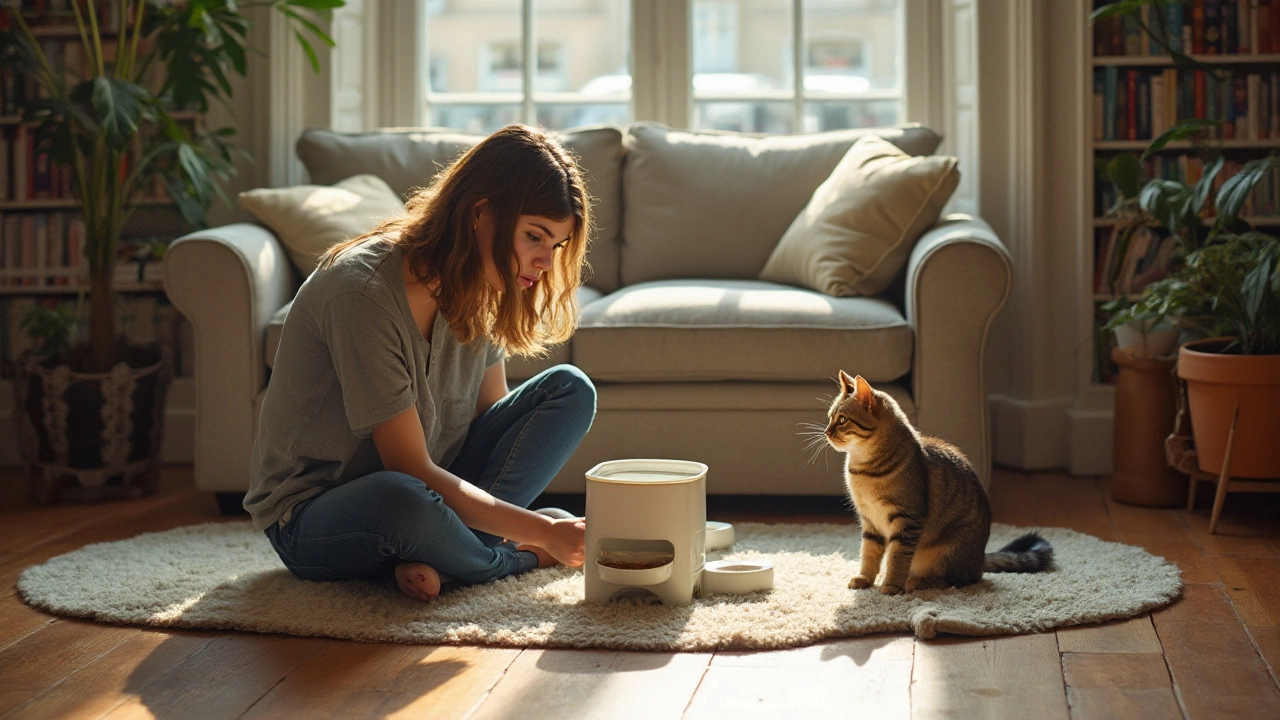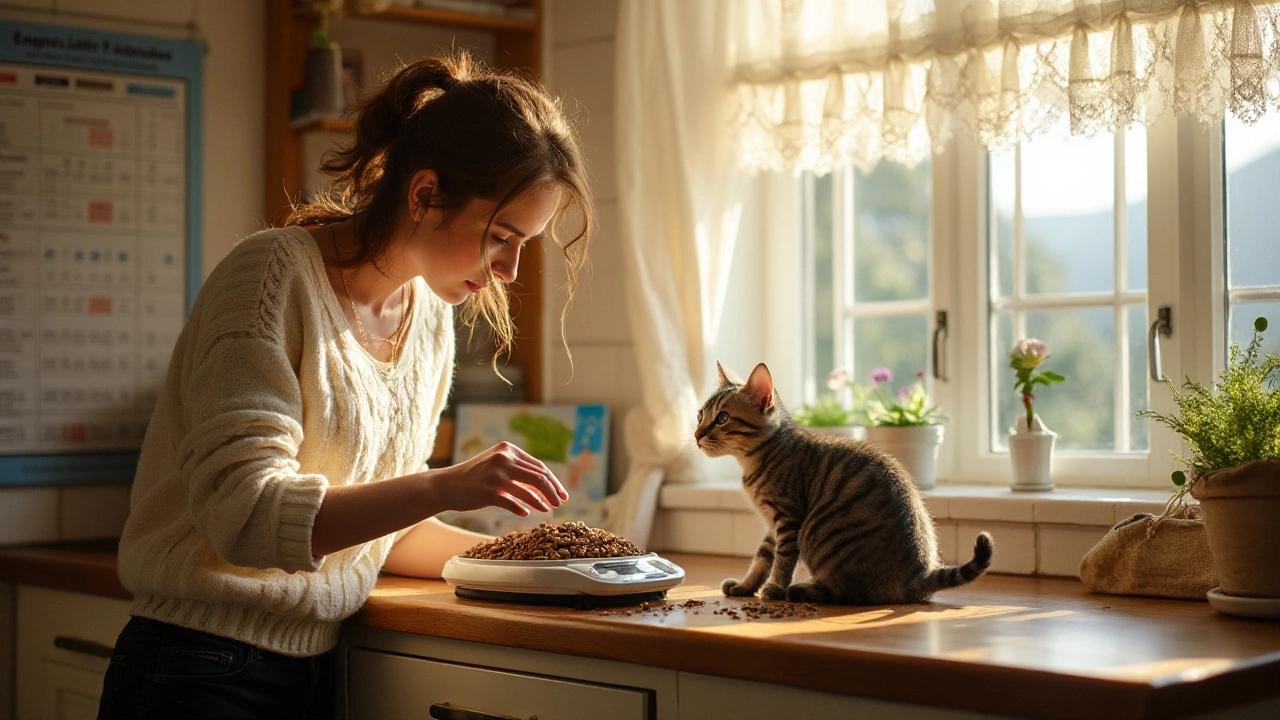Having a cat in your life brings warmth and affection, but it also means being responsible for their dietary needs. The question of how often to feed your cat can seem simple, but it involves understanding their nutritional requirements and lifestyle.
Each cat is unique and will have different feeding needs throughout their life stages, from playful kitten days to adult leisurely times. In this article, we'll unravel the common myths about feeding cats and guide you towards establishing a healthy routine. Whether you're a first-time cat owner or looking for advice to fine-tune your existing schedule, this guide aims to provide you with valuable insights and practical tips.
- Understanding Cat Dietary Needs
- Feeding Kittens vs. Adult Cats
- Portion Control and Timing
- Special Cases: Health and Lifestyle
- Tips for Managing Feeding Routines
Understanding Cat Dietary Needs
Cats have captivated the human imagination for centuries, not only for their mysterious grace but also for their distinct dietary needs. Unlike dogs, which are omnivorous, cats are obligate carnivores. This means their diet is highly specialized, designed by nature to derive nutrients primarily from animal sources. At the core of a cat's nutritional needs is the presence of high-quality protein, found abundantly in meats. Proteins are essential for maintaining lean body mass, healthy skin, and a glossy coat. Beyond just protein, your feline friend needs specific amino acids like taurine, which helps prevent heart disease and supports a healthy vision. Without taurine, derived mainly from meat, cats can’t thrive, illustrating the complete necessity of a meat-based diet.
Water intake is another critical aspect of a cat's diet. Cats naturally have a low thirst drive due to their desert ancestry, so they depend significantly on their food for hydration. This is why wet food, with its higher moisture content, is often recommended, especially if you notice your cat isn't drinking much from their bowl. Interestingly, a cat's individual dietary needs can shift based on life stage and health status. For instance, a kitten requires more calories and protein for growth, while a senior cat may need a diet adjusted to promote kidney health. Understanding these subtle changes is crucial in tailoring the diet to meet their specific demands.
"The domestic cat is the only member of the Felidae family that is typically kept inside, drawing more attention to how closely we must monitor their nutrition," notes Dr. Sarah Ellis, a noted researcher on feline behavior.
A vast array of cat food options can be overwhelming, but discerning the highest quality from the pack is vital. Examine the ingredient list for whole foods, avoiding artificial preservatives and fillers like corn or soy. Ingredients are listed by quantity, so seeing meat or fish at the top of the list is a promising sign. On the flip side, being wary of grain-heavy diets can guard against unnecessary weight gain and digestive issues. Nutritionists also emphasize fatty acids such as omega-3 and omega-6, which are pivotal in developing brain function and maintaining joint health.
The cat diet can be further refined with supplements or specific ingredients that address unique needs. For example, glucosamine can be essential for joint health in older cats, while probiotics may aid those with sensitive stomachs. Some believe that raw food diets mimic the natural eating habits of wild felines more closely, though such diets come with their own sets of benefits and potential risks. Whatever dietary path you explore, consulting with your veterinarian ensures that your feeding choices align with your pet's health requirements and lifestyle.
| Cat Life Stage | Caloric Needs | Protein Percentage |
|---|---|---|
| Kitten | 200-250 kcal/day | 30-40% |
| Adult Cat | 180-200 kcal/day | 25-30% |
| Senior Cat | 130-150 kcal/day | 25-30%, moderate to high fiber |
With this basic understanding of a cat's dietary needs, you are better equipped to navigate the plethora of choices available in pet stores. By choosing the right types of food and paying attention to your cat's unique lifestyle and health conditions, you can ensure a diet that not only keeps them healthy but also content and happy. Remember, monitoring their weight, output, and energy levels will give you the best clues about their nutritional health.
Feeding Kittens vs. Adult Cats
When it comes to feeding kittens versus adult cats, the distinction is more significant than most would assume. Kittens are in a rapid growth phase, requiring a diet dense in calories and nutrients. Typically, a kitten's diet should consist of food specifically formulated to meet their high energy needs. These meals are fortified with essential vitamins, minerals, and higher protein to sustain their fast development. During the first few months of life, kittens often need to be fed about four times a day. This frequent schedule ensures they receive adequate nutrition without overburdening their tiny stomachs. Over time, this feeding frequency can be reduced gradually as they approach one year. Choosing high-quality kitten food is crucial, as it supports their development into healthy, strong adult cats.
Adult cats, on the other hand, require a more balanced approach to diet that focuses on maintaining a healthy weight and overall health. Unlike kittens, adult cats tend to eat once or twice a day, depending on their activity level and health status. High-protein and low-carbohydrate diets are often recommended to prevent obesity and related health issues. The challenge for adult cat owners is to accurately gauge and adjust portion sizes, typically using guidelines on the food packaging as a starting point. Ensuring your cat has access to fresh water at all times is also a crucial part of their diet, as hydration affects digestion and overall well-being.
Another consideration when feeding adult cats is their lifestyle. Indoor cats may require fewer calories than their outdoor counterparts due to less physical activity. Metabolic rates can vary greatly between individual cats. Spaying and neutering can also affect your cat's dietary needs. According to a study published in the Journal of Animal Physiology and Animal Nutrition, neutered cats often experience a decrease in metabolic rate. Thus, they may require fewer calories compared to unaltered cats. A cat food mixer at the National Geographic Society, Sarah, once noted, "The true key to feeding a cat effectively is not just understanding the food itself but also observing and adapting to changes in the cat's behaviors and habits."

Portion Control and Timing
When setting up your cat's feeding schedule, one of the crucial elements to consider is portion control. Knowing the right amount of food to offer helps maintain their health, prevent obesity, and ensure they're getting the essential nutrients they need. Often, cats can become habituated to overeat if given unrestricted access to food all day, leading to potential health issues. A good starting point is to consult your cat food packaging or a vet for specific daily portion recommendations. Typically, adult cats require around 20 calories per pound of body weight each day. This can vary by their activity level, age, and specific dietary needs.
Timing is another key aspect of feeding cats. Most pet nutritionists suggest feeding adult cats twice a day – once in the morning and once in the evening. This aligns closely with their natural eating habits which usually involve hunting smaller prey several times throughout the day. Establishing a usual feeding routine not only supports their physiological functions but also helps in managing their behaviors – a hungry cat is often a mischievous one! Kittens, however, need more frequent feeding times due to their rapid growth and higher energy needs, so offering food three to four times a day is advisable.
Precisely balancing portion control with feeding times can help in avoiding any nutritional deficiencies or excess. A prior study from the Journal of Feline Medicine and Surgery suggested that regular feeding intervals complimented with proper portions can significantly reduce the risks of diabetes in cats. To ensure accuracy in portions, using a digital scale to weigh the cat food can be quite effective, as scoops and cups can lead to inconsistent measurements. Additionally, if your feline friend shares their space with other pets, keeping an eye on their eating habits can prevent future 'food theft' and encourage appropriate eating behaviors.
"Many go wrong with cat nutrition because they follow the human schedule instead of considering their pet's natural instincts," stated Dr. Jane Robertson, a renowned feline nutrition specialist. She elaborates, emphasizing the need for observing and adapting to your cat's unique lifestyle needs rather than adhering strictly to prescribed norms.
Being mindful of these feeding elements can set your cat on a path to better health and a more balanced lifestyle. Certain cat types with special needs, such as senior cats or those with medical conditions like hyperthyroidism, might require tailored feeding plans recommended by veterinarians. But, no matter the breed or age, speaking with a professional can assure that your cat receives the nourishment they need to thrive. Remember, a healthy diet is the first step to a longer, happier life for your precious pet.
Special Cases: Health and Lifestyle
Cats, much like humans, are unique individuals. Their dietary needs can be affected by several factors beyond age and breed, including health conditions and lifestyle choices. Understanding these elements is essential for tailoring a nutritional plan that keeps your feline friend purring healthily. One important consideration is any underlying health conditions that might impact feeding routines. Cats with diabetes or kidney disease, for instance, require specific diets and feeding schedules to manage their condition well. These tailored diets typically consist of high moisture content food to support organ health or low carbohydrate choices to regulate blood sugar levels efficiently. Engaging with your veterinarian can provide the right insight into dietary adjustments for these conditions, ensuring your cat's diet supports their health journey.
Activity levels also play a critical role in determining how frequently and how much your cat should eat. Outdoor cats, who might spend considerable time roaming and exploring, often need more sustenance compared to their indoor counterparts. These cats burn more calories and thus benefit from meals that are spread throughout the day to maintain their energy levels. Indoor cats, on the other hand, might be less active, so portion control becomes crucial to prevent obesity. A balance in diet helps in fostering a lifetime of health, ensuring each bite counts.
There's a common worry among pet owners about maintaining a feeding routine while accommodating busy lifestyles. One effective approach is using automatic feeders, which can dispense controlled portions of food at set intervals. This tool is especially useful for ensuring consistency, crucial for cats with specific health considerations, and can be a real lifesaver during hectic days. Creativity in feeding, such as introducing interactive feeders and puzzles, not only makes mealtime fun but also mentally stimulates your pet, mimicking the natural hunting instinct.
According to Dr. Jane A. Brunt, executive director of the CATalyst Council, “Cats are obligate carnivores, so their diet must be predominantly based on meat. It’s essential that pet owners tweak their pet's feeding schedules in line with their health needs.”
Being attuned to your cat’s specific needs, whether they're health-driven or based on lifestyle, contributes significantly to their overall welfare. It's this attentiveness that not only ensures they’re well-fed but also supports their happiness and longevity. Remember, while there are general guidelines, your cat may sometimes have peculiar preferences or requirements, which makes regular check-ins with professional veterinarians all the more critical.

Tips for Managing Feeding Routines
Creating a feeding routine for your feline friend can significantly impact their well-being and behavioral patterns. Cats thrive on predictability, so maintaining a consistent schedule can help ease their anxiety and promote better digestion. If you're seeking to fine-tune your feeding habits at home, there are practical strategies you can employ that cater to your cat's natural instincts while keeping their nutritional needs at the forefront. Start by determining a reliable feeding schedule, and you'll soon notice a content and healthier cat.
One tip to ensure your cat is thriving is to tailor their feeding routine to fit their lifestyle, particularly if they fluctuate between indoors and the great outdoors. Indoor cats may require fewer calories compared to their active outdoor counterparts who burn more energy hunting or exploring. It's essential to revisit their dietary needs periodically, especially if there’s a noticeable change in their environment or activity level. An effective way to gauge if your cat's feeding schedule is suitable is by monitoring their weight and adjusting portion sizes or meal frequency as necessary. However, always do this gradually to allow your pet's system to adapt smoothly.
"Cats are crepuscular, meaning they are most active during the dawn and dusk. This natural rhythm suggests that feeding them during these times can align with their instinctual behaviors, possibly reducing nocturnal disturbances," advises pet nutritionist Dr. Luna C. Tails.
Understanding the importance of meal composition is another cornerstone. Ensuring your pet receives a balanced diet catering to their specific nutritional needs can make all the difference. Consult your vet about the best types of food suited for your cat's age and health requirements, and experiment with a mix of dry and wet food. Each form offers unique nutrients and hydration levels—acknowledge your cat’s preference but aim for a nutritious combination.
It's also worth considering tech solutions that can lend a hand in maintaining precision with your feeding routine. Smart feeders are increasingly popular, enabling you to schedule various meals throughout the day. They can be a real game-changer, especially if your daily schedule is unpredictable. Whether it's staving off early morning wake-up yowls or ensuring that mid-day feeds are not missed, these gizmos provide a reliable and flexible option. Remember to balance technology with personal involvement—a simple scoop of food paired with a friendly scratch behind the ears reinforces the bond.
The feeding routine is more than just meals; it's a moment of connection with your cat. Allow some time post-feeding for leisurely interaction. This can take the form of gentle play or relaxation, supporting their mental health. A common misstep in managing feeding habits is forgetting that cats' enthusiasm can often lead to overeating if there aren't clear boundaries. Monitor for signs of weight gain and modify their diet if necessary, always in consultation with veterinary advice.
